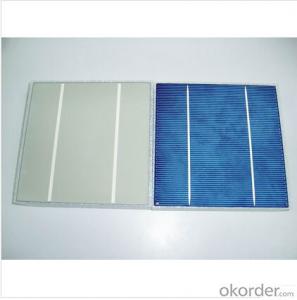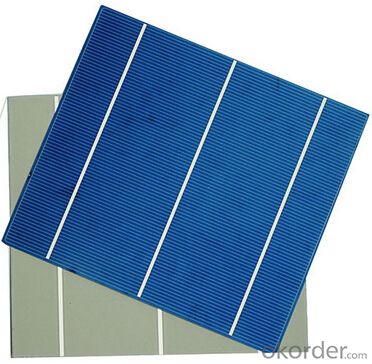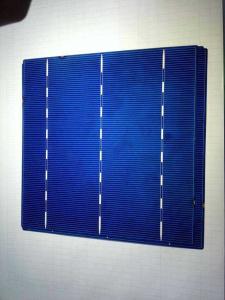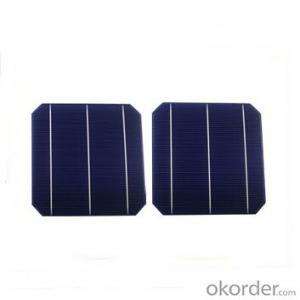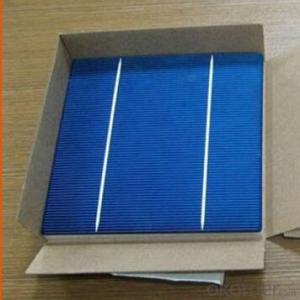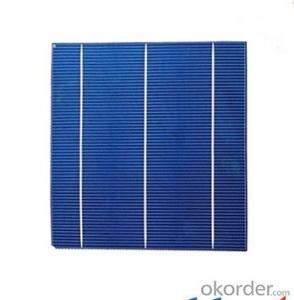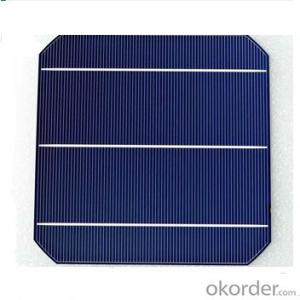LG Polycrystalline Solar Cells High Quality 17.40-19.20% Efficiency
- Loading Port:
- Shanghai
- Payment Terms:
- TT OR LC
- Min Order Qty:
- 1000 pc
- Supply Capability:
- 1000000 pc/month
OKorder Service Pledge
OKorder Financial Service
You Might Also Like
Solar Cells:
solar cells, when struck by photons of light from the sun, generates an electrical current which can then be used to power DC or AC electrical loads.
A solar cell is made of silicon. Computer chips are made of this same material. Basically, when light strikes the surface of a solar cell some of it is absorbed into the silicon. This light energy bumps the electrons loose and causes energy to flow
Solar cells is made by solar wafer, it has three categories of solar cell right now, monocrystalline polycrystalline and thin film,These cells are entirely based around the concept of PN junction, which is the critical part of solar module, it is the part that can convert the light energy into electricity, the thickness is from 180um to 200um, with even busbars to conduct electricity, textured cell can decrease diffuse reflection; they are often electrically connected and encapsulated as a module. Photovoltaic modules often have a sheet of glass on the front (sun up) side, allowing light to pass while protecting semiconductor wafers from abrasion and impact due to wind-driven debris, rain, hail, etc. Solar cells are also usually connected in series in modules, creating an additive voltage. Connecting cells in parallel will yield a higher current;With high quality and stable quality. Our Cells can greatly improve the performance of Solar Modules.
Specifications
Format | 52x78mm±0.5mm |
Diameter | 220±0.5mm |
Thickness | 200±20um |
Weight | 2±0.5g |
Front(-) | 1.8mm bus bars (Silver) |
Blue anti-reflecting coating (Silicon nitride) | |
Back (+) | 3mm wide soldering pads (Silver) |
Back surface field (aluminum). |
Efficiency code | 1720 | 1740 | 1760 | 1780 | 1820 | 1840 | |
Efficiency (min) | (%) | 17.2 | 17.4 | 17.6 | 17.8 | 18.2 | 18.4 |
Pmax | (W) | 4.186 | 4.234 | 4.283 | 4.332 | 4.429 | 4.478 |
Voc | (V) | 0.631 | 0.632 | 0.634 | 0.636 | 0.640 | 0.642 |
Isc | (A) | 8.446 | 8.485 | 8.523 | 8.573 | 8.660 | 8.700 |
Vmp | (V) | 0.525 | 0.527 | 0.529 | 0.531 | 0.535 | 0.537 |
Imp | (A) | 7.973 | 8.035 | 8.097 | 8.160 | 8.280 | 8.340 |
Solar Cells Advantage:
• High efficiency and stable performance in photovoltaic conversion.
• Advanced diffusion technique ensuring the homogeneity of energy conversion efficiency of the cell.
• Advanced PECVD film forming, providing a dark blue silicon nitride anti-reflection film of homogenous color and attractive appearance.
• High quality metal paste for back surface and electrode, ensuring good conductivity, high pulling strength and ease of soldering.
• High precision patterning using screen printing, ensuring accurate busbar location for ease with automatic soldering a laser cutting.
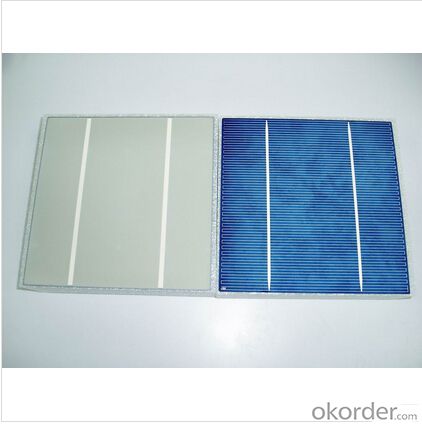
FAQ
We have organized several common questions for our clients,may help you sincerely:
①What price for each watt?
It depends on the efficiency of the solar cell, quantity, delivery date and payment terms.
②How long can we receive the product after purchase?
In the purchase of product within three working days, We will arrange the factory delivery as soon as possible. The pecific time of receiving is related to the state and position of customers.Commonly 7 to 10 working days can be served.
③Can you provide the peripheral products of the solar panels, such as the battery, controller, and inverter? If so, can you tell me how do they match each other?
Yes, we can, we have two companies for solar region, one is CNBM International, the other is CNBM engineering Co.
We can provide you not only the solar module but also the off grid solar system, we can also provide you service with on grid plant.
④What is your warranty of solar cell?
Our product can promise lower than 0.3% open box crack, we support claim after opening the box if it has crackm color difference or sth, the buyer should give pictures immediately, we can not accept the claim after the solar cell has assembled to solar panel.
• Timeliness of delivery
• ⑤How do you pack your products?
We have rich experience on how to pack the solar cell to make sure the safety on shipment, we could use wooden box or pallet as buyer's preference.
- Q: What is the impact of solar cells on reducing energy waste?
- Solar cells have a significant impact on reducing energy waste as they harness clean and renewable energy from the sun, thus reducing the need for fossil fuels. By converting sunlight into electricity, solar cells provide a sustainable and environmentally friendly alternative, reducing greenhouse gas emissions and dependence on non-renewable energy sources. This helps combat climate change and promotes a more efficient use of energy, ultimately decreasing energy waste.
- Q: Can solar cells be used in greenhouses or agricultural facilities?
- Yes, solar cells can be used in greenhouses or agricultural facilities. By harnessing the power of the sun, solar cells can generate electricity to power various operations within these facilities, such as lighting, heating, ventilation, and irrigation systems. Additionally, solar cells can help reduce energy costs and carbon emissions, making them a sustainable and eco-friendly choice for agricultural practices.
- Q: How do solar cells perform in areas with frequent earthquakes?
- Solar cells can generally perform well in areas with frequent earthquakes as they do not have any moving parts and are not typically affected by ground vibrations. However, it is essential to ensure that the solar panels are properly installed and secured to withstand potential damages caused by seismic activities. Additionally, regular maintenance and inspections may be necessary to ensure the structural integrity of the solar system in earthquake-prone areas.
- Q: What is the difference between a solar cell and a solar panel?
- A solar cell is a single unit that converts sunlight directly into electricity, while a solar panel consists of multiple solar cells connected together to generate a higher amount of electricity.
- Q: What is the impact of tree shading on solar cell efficiency?
- Tree shading can have a significant impact on solar cell efficiency. When trees cast shadows on solar panels, they reduce the amount of sunlight reaching the cells, resulting in decreased electricity generation. The shading not only reduces the overall energy output but also causes uneven distribution of light, leading to hotspots on the panels, which can further decrease their efficiency and lifespan. Therefore, it is important to consider tree placement and regularly trim branches to maximize solar cell efficiency.
- Q: The history of solar cells
- Lithium battery Lithium battery is a class of lithium metal or lithium alloy for the anode material, the use of non-aqueous electrolyte solution of the battery.
- Q: What materials are used to make solar cells?
- Solar cells are primarily made using materials such as silicon, which is the most commonly used material, as well as other semiconductor materials like cadmium telluride, copper indium gallium selenide, and perovskite.
- Q: Can solar cells be used for powering offshore oil rigs?
- Yes, solar cells can be used for powering offshore oil rigs. They provide a sustainable and reliable source of energy, reducing the reliance on fossil fuels and minimizing the environmental impact. Additionally, advancements in solar technologies have made them more efficient and capable of withstanding harsh offshore conditions, making them a viable option for offshore oil rig power generation.
- Q: Can solar cells be used in museums?
- Yes, solar cells can be used in museums. They can be used to power various devices and lighting within the museum, reducing reliance on traditional energy sources and contributing to a more sustainable and environmentally friendly operation. Additionally, solar cells can be integrated into the design of museum buildings, providing a visually appealing and efficient way to generate renewable energy.
- Q: Can solar cells be used for air conditioning?
- Yes, solar cells can be used for air conditioning through the utilization of solar-powered air conditioning systems. These systems convert solar energy into electricity, which is then used to power air conditioning units, enabling cooling without relying on traditional energy sources.
Send your message to us
LG Polycrystalline Solar Cells High Quality 17.40-19.20% Efficiency
- Loading Port:
- Shanghai
- Payment Terms:
- TT OR LC
- Min Order Qty:
- 1000 pc
- Supply Capability:
- 1000000 pc/month
OKorder Service Pledge
OKorder Financial Service
Similar products
Hot products
Hot Searches
Related keywords
